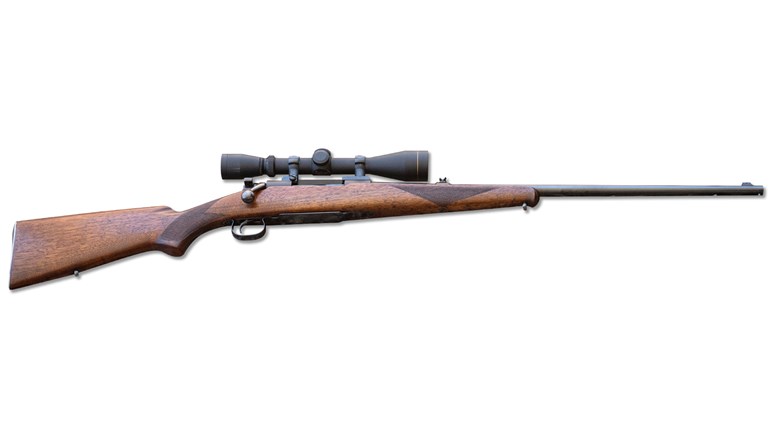
Winchester’s USA Ready Defense ammunition looks to be a reliable and effective option for use in self-defense handguns.
Inserting polymer into a defensive-handgun bullet is nothing new. In 1999, Federal finalized the design of the expanding full-metal-jacket bullet (EFMJ) which used a polymer insert ahead of a lead core, inside a full-metal-jacket bullet. In 2009, Hornady introduced Critical Defense ammunition and, a few years later, its Critical Duty loads. Both utilized a polymer plug inserted into the bullet’s hollow-point cavity. The concept was that the polymer would prevent the clogging of the cavity while at the same time promoting bullet upset. In 2021, Winchester introduced USA Ready Defense ammunition, which also uses a polymer insert in the bullet’s hollow-point cavity. But, Winchester’s polymer insert is a bit different.
Winchester’s USA Defense ammo descends from its Ranger One law-enforcement line of handgun ammunition. Like Ranger One, USA Ready Defense bullets have their hollow point filled with a polymer insert. And, just as with Hornady’s Critical Defense and Critical Duty loads, the polymer insert in Winchester’s USA Ready Defense is there to help prevent the hollow-point cavity from clogging with fabric or other intermediate-barrier materials the bullet might pass through. But, unlike the solid-polymer insert used by Hornady, Winchester uses sort of a finned affair it advertises as “Hex-Vent” technology. It is purposely designed to help direct fluids against the inside walls of the hollow-point cavity to help initiate and promote bullet upset. Winchester claims its Hex-Vent bullets will penetrate to at least 12 inches, regardless of caliber and/or cartridge.
The primary difference noted between Winchester’s USA Ready Defense and its Ranger One law-enforcement loads is that the Ranger One bullets are bonded and the USA Ready Defense bullets are not. Another difference is that the polymer inserts in the Ranger One loads are blue, while they’re red in the USA Ready Defense ammunition. Bullet weights for Ranger One ammunition are a bit heavier for each cartridge, too.
Currently, Winchester offers four loads in the USA Ready Defense line. It has a 124-grain 9 mm +P load, a 170-grain .40 S&W offering, a 170-grain 10 mm projectile and a 200-grain .45 ACP load. All these loads utilize nickel-plated cases and match-grade primers. Uniquely, Winchester advertises that you can find the actual ballistics data by manufacturer lot number for each of these loads online at winchester.com. I tried to view this data for USA Ready Defense loads I had for testing, but only the 9 mm +P 124-grain Hex-Vent JHP load was listed. Unfortunately, the lot number for that load (Lot 17) was not listed.
Maybe Winchester is a bit behind in posting the data for this ammunition. I did view its information for Lot 14 of the 9 mm +P 124-grain Hex-Vent JHP and it showed a muzzle velocity of 1,204 fps measured at 15 feet from a 4-inch barrel, with a pressure of 34,175 psi measured with a conformal piezotransducer, and a five-shot-group size of 1.21 inches fired form a 4-inch barrel at 50 yards. This may or may not interest you, but it is unique information for a manufacturer to share, and Winchester should be applauded for its transparency. Maybe the next step would be to show actual terminal performance for each lot number, which is information I’m sure would interest most of us who might be considering purchasing this ammo.
I had samples of the 9 mm, 10 mm, and .45 ACP USA Ready Defense ammunition and I tested these in a SIG Sauer P365 with a 3.1-inch barrel, a Tisas 1911 D10 with a 5-inch barrel and a Tisas 1911 Bantam Carry with a 4.25-inch barrel, respectively. The advertised velocity of the 9 mm +P load is 1,200 fps, and it averaged 1,164 fps out of the P365. The 200-grain .45 ACP load has an advertised velocity of 1,000 fps, and out of the 4.25-inch barrel it averaged 970 fps. The surprise was the 10 mm load, which is advertised at 1,250 fps. It screamed out of the 5-inch barrel at 1,320 fps. Another surprise was that the standard velocity deviations for all three loads combined averaged less than 15 fps.
To test for accuracy/precision, I fired five-shot groups from a sandbag rest at 10 yards. The .45 ACP and 10 mm loads cut one ragged hole in the target. The 9 mm load grouped into just a tad more than an inch, but keep in mind that the 9 mm load was tested out of a pistol with a 3.1-inch barrel and with a much shorter sight radius. I then fired 100 rounds of each load while running various defensive handgun drills to check reliability. The only stoppage experienced was the last round in a 10 mm magazine that failed to fully chamber when I was shooting from the bench. More than likely, I limp-wristed that shot.
To test terminal performance, I fired three rounds of each load into uncovered blocks of Clear Ballistics and another three rounds into blocks of Clear Ballistics covered with two layers of denim. I was quite impressed with the results. Every round fired penetrated to at least 12 inches and none penetrated more than 16.5 inches. The average bullet upset for every shot fired—including those fired through two layers of denim—was 1.51 times original bullet diameters.
Winchester should be proud of its USA Ready Defense product. The Hex-Vent technology seems to work as designed, the nickel-plated cases should help prevent corrosion and will undoubtedly aid with cycling reliability. From the standpoint of terminal-performance, all three loads fall right in line with what the FBI considers acceptable in terms of penetration and bullet upset. Prices for USA Ready Defense ammunition are also compatible with trusted self-defense handgun loads from other manufacturers. I’ve been working with and frequently carrying a Glock G43X. Right now, it’s loaded with the 124-grain +P 9 mm USA Ready Defense load. That’s the best endorsement I could give any self-defense handgun ammunition.






































